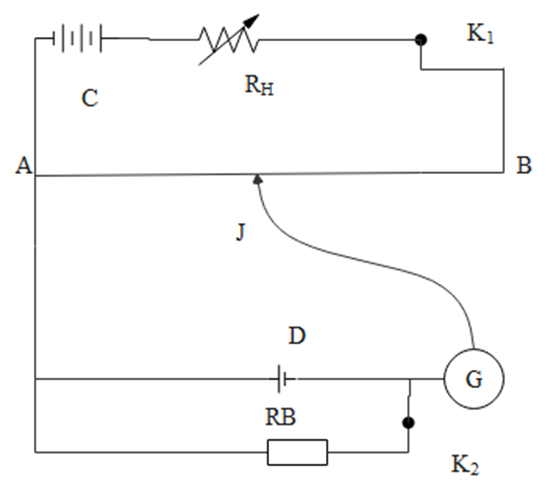
Answer
474.9k+ views
Hint: Detailed knowledge about the internal resistance of a potentiometer is needed for solving this question. The formula of internal resistance r is given by
$r=\left( \dfrac{v{{l}_{1}}}{v{{l}_{2}}}-1 \right)R=\left( \dfrac{{{l}_{1}}}{{{l}_{2}}}-1 \right)R$
This equation is derived from the formula of electric field and electric potential.
Internal resistance depends upon the nature of the material of the wire.
Complete step by step answer:
(i)Labelled circuit diagram:

In the circuit, there is a Potentiometer wire, variable resistance ,an accumulator , an experimental cell, a galvanometer G, resistance box RB, $K_1$ and $K_2$ are the keys and a jockey
(ii)Derivation of formula: Let the E be the emf of the experimental cell and its internal resistance is r. If a resistance box is connected by a resistance R with this cell then the potential difference at the ends of the cell becomes V.
Then, Electric field and the potential can be written as,
$E=I\left( R+r \right)$
$r=\left( \dfrac{{{l}_{1}}}{{{l}_{2}}}-1 \right)R$
Then
$r=\left( \dfrac{E}{V}-1 \right)R$…………. (1)
Assume the potential gradient of the potentiometer be v.
Let the balance point is at distance from A when R is not connected,
Then
$E=v{{l}_{1}}$ ………………. (2)
Let the balance point is obtained at a distance from A after connecting R. Then the potential difference at the ends of the cell
$V=v{{l}_{2}}$ ….............. (3)
Substitute eqns. (2) and (3) in (1),
$r=\left( \dfrac{v{{l}_{1}}}{v{{l}_{2}}}-1 \right)R=\left( \dfrac{{{l}_{1}}}{{{l}_{2}}}-1 \right)R$
(iii) Observation table:
(iv)Precaution: Two precautions are there. Firstly the diameter of potentiometer wire should be uniform everywhere, otherwise potential gradients will not be similar everywhere.Secondly, before null position, shunt should be connected with the galvanometer. Even though the shunt should be removed near the null point.
Note:
Internal resistance is the opposition offered by the cells and batteries to the flow of current forming in the generation of heat. Potentiometer is an instrument for measuring emf by balancing it against the potential difference generated by passing a certain current through a certain variable resistance.
$r=\left( \dfrac{v{{l}_{1}}}{v{{l}_{2}}}-1 \right)R=\left( \dfrac{{{l}_{1}}}{{{l}_{2}}}-1 \right)R$
This equation is derived from the formula of electric field and electric potential.
Internal resistance depends upon the nature of the material of the wire.
Complete step by step answer:
(i)Labelled circuit diagram:

In the circuit, there is a Potentiometer wire, variable resistance ,an accumulator , an experimental cell, a galvanometer G, resistance box RB, $K_1$ and $K_2$ are the keys and a jockey
(ii)Derivation of formula: Let the E be the emf of the experimental cell and its internal resistance is r. If a resistance box is connected by a resistance R with this cell then the potential difference at the ends of the cell becomes V.
Then, Electric field and the potential can be written as,
$E=I\left( R+r \right)$
$r=\left( \dfrac{{{l}_{1}}}{{{l}_{2}}}-1 \right)R$
Then
$r=\left( \dfrac{E}{V}-1 \right)R$…………. (1)
Assume the potential gradient of the potentiometer be v.
Let the balance point is at distance from A when R is not connected,
Then
$E=v{{l}_{1}}$ ………………. (2)
Let the balance point is obtained at a distance from A after connecting R. Then the potential difference at the ends of the cell
$V=v{{l}_{2}}$ ….............. (3)
Substitute eqns. (2) and (3) in (1),
$r=\left( \dfrac{v{{l}_{1}}}{v{{l}_{2}}}-1 \right)R=\left( \dfrac{{{l}_{1}}}{{{l}_{2}}}-1 \right)R$
(iii) Observation table:
| S l no | When cell is open circuited with balancing length | When cell is close circuited with balancing length | Resistance used in resistance box | Internal resistance |
| 1 | cm | cm | ohm | ohm |
(iv)Precaution: Two precautions are there. Firstly the diameter of potentiometer wire should be uniform everywhere, otherwise potential gradients will not be similar everywhere.Secondly, before null position, shunt should be connected with the galvanometer. Even though the shunt should be removed near the null point.
Note:
Internal resistance is the opposition offered by the cells and batteries to the flow of current forming in the generation of heat. Potentiometer is an instrument for measuring emf by balancing it against the potential difference generated by passing a certain current through a certain variable resistance.
Recently Updated Pages
A very dilute acidic solution of Cd2+ and Ni2+ gives class 12 chem sec 1 JEE_Main

Calculate the equivalent resistance between A and class 12 physics JEE_Main

The potential difference between points A and B in class 12 physics JEE_Main

A wire is bent in the form of a triangle now the equivalent class 12 physics NEET_UG

For the circuit shown in figure the equivalent capacitance class 12 physics JEE_Main

If on applying the potential of 20 V on a conductor class 12 physics JEE_Main

Trending doubts
Which are the Top 10 Largest Countries of the World?

What is the definite integral of zero a constant b class 12 maths CBSE

Differentiate between homogeneous and heterogeneous class 12 chemistry CBSE

Explain sex determination in humans with the help of class 12 biology CBSE

How much time does it take to bleed after eating p class 12 biology CBSE

Distinguish between asexual and sexual reproduction class 12 biology CBSE




